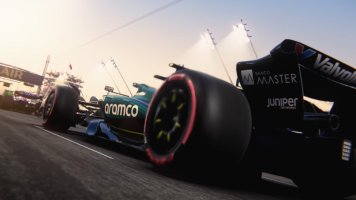Regards D-Box haptics.
Even on a standard installations with no other isolation for seat/pedals sections.
The advice I would give is to not just rely on specifications that state it supports upto @100Hz.
I have never seen showcased methods by owners or indeed reviewers, seeking to determine from that range the following:
A) What are the best-felt frequencies it outputs?
B) As higher frequencies have much less energy/bandwidth.
It is possible those above @80Hz may not be felt that well or add much in felt benefits, instead only vaguely noticeable.
C) Who or when will someone, give more insight into the effects D-Box has.
For example, what are the best-felt rpm with the engine?
What are the frequencies it is generating at its best?
What are the rpm that the felt sensation drops off?
What are the frequencies it is generating when the felt detail begins to decrease?
We have to factor in that, the distance from the actuator to that of the seat/pedals. Also taking into account different materials and installations.
These may have some bearing on what actual frequencies a D-Box really is delivering that are most enjoyed.
Also no indications whatsoever if effects use many variations with the frequencies they output. Or how the system actually deals with mono-based effects and positional-based effects.
I went to the bother of showing this to highlight frequencies and bandwidth ranges. People can get a nice visualisation of the size of the boxes and how one relates to the other.
For D-Box we need to determine what is shown here below. What its general felt range is, what its best felt or peak range is?
This also highlights how much a budget tactile system lacks in comparison to the possibilities and potential advanced tactile can deliver.

* Take note of the size of the grid boxes between frequencies.
Also for budget tactile owners, just look how narrow the peak frequency bandwidth is (bottom right). It is within this range most of you with budget/entry-level hardware try to use for experiencing the (most punch) for multiple effects. Compare that to the combined size of the large BK and TST.
The thinner/narrower the box segments become the harder it would be to feel them from further distances or potentially through different materials. Just look how thin 70-80-90-100 are.
This is one reason why exciters and tst units placed more directly to seat supports or seat body will deliver much better the finer details the higher frequencies use. Also most of the budget transducers are not that good above 80Hz so we find the TST and EXC models superb for these duties.
People will use test tones to test individual frequencies and determine from that they offer very little.
Higher octaves and harmonics are not about an individual or pure tone. They are about inserting/adding extra detail, warmth, audible character and richness when used with other lower frequencies. Applying with effects creation options to produce a more musical approach and provide the best-suited hardware with an installation method to best deliver it.
If it was discovered what frequencies D-Box used, it could be possible if desired to supplement what is being lost from the D-Box felt output. Not only to replace this with Simhub effects delivering suitable frequencies but potentially even better performance with the recommended hardware possibilities that have been tried and tested.
Become creative or don't bother!
While a potential factor, before stating that having additional isolation may be a drawback for those with additional tactile hardware.
I would advise people to determine the above on standard installations and then from that people with installed isolation can compare. That way you will at least discover what frequencies are making it through from the effects the motion haptics offers.
As I have highlighted if we learn what it uses for specific effects, then it is also possible to have additional tactile use Simhub-based effects that work in conjunction with it. Nobody it seems has tried.
In some scenarios like engines, I do not expect the D-Box will come close to what the potential is with what can be done in Simhub.
Positional-based effects and the energy it can produce with these are the effects that will likely stand out.
Yet we still do not have confirmation regards mono-based effects and positional-based effects on how D-Box deploys these.
Are they 4 way independent, front/back stereo based or left/right stereo based or the average of 4-way telemetry output as a single channel and then this sent to each actuator?
Much to discover before you can really seriously seek to determine how to best incorporate advanced tactile with the motion haptics.











